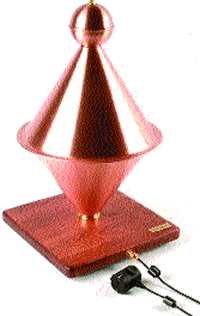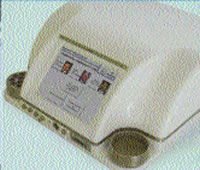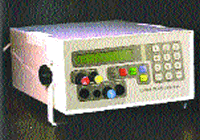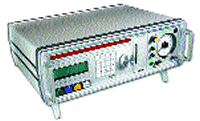Positive Health Online
Your Country

Bioresonance Part II: Practical Approaches to Treatment
listed in energy medicine, originally published in issue 139 - September 2007
In the second of this two-part article on bioresonance, I examine the practical ways in which bioresonance is being applied in complementary therapy today. Not yet available on the NHS, bioresonance is, nevertheless, finding a wide range of applications in complementary medicine clinics, from smoking cessation, allergy treatment and gastro-intestinal disorders to rheumatoid arthritis.
The history and theoretical basis of bioresonance was discussed in the first part of this article. In this second part I take a look at some of the many ways in which bioresonance is being practised by British complementary therapists.

Rayonex Duplex Mk III
Rayocomp PS1000 Polar
Telesound of Malvern’s Mk 6
Bicom
Bioresonance Instruments
There are now more than two dozen different bioresonance therapeutic instruments on the market today for use by practitioners. These include Rayocomp PS1000, BICOM 2000, Rayonex, Inergetics-CoRe, MORA, Vegatest, Skenar etc, most of which are described on the Internet which identifies some 17,000 websites using the keywords ‘bioresonance’ and ‘disease’.
Even Entrez Pubmed lists around 30 peer reviewed studies, though most of these are foreign, or simply reviews, or without abstracts. It would appear that despite its critics, bioresonance is regaining an increasing foothold in complementary therapy, notwithstanding a somewhat flimsy experimental scientific base and controversial background.
Conditions Treated with Bioresonance
What kind of disorders are claimed to be treatable by bioresonance? Arguably the most spectacular is smoking addiction.[1] In an infamous TV broadcast in November 2005, Richard and Judy, the presenters, followed the progress of two long-term smoking journalists keen to kick the habit. Both appear to have succeeded, and both reported the same symptoms during the withdrawal process after a single bioresonance treatment. Similar reports appeared variously in the Daily Telegraph, on BBC News 24 and in other major newspapers in following years.
When smoking in public places was banned in Wales in April 2007 an estimated 46,000 vowed to give up the habit. From July the same ban affected England, so demand for bioresonance is likely to increase, perhaps markedly. The occasion would provide an opportunity for a large-scale placebo-controlled trial, as well as being the single most important thing any smokers can do for their health. Bioresonance practitioners claim that their approach is effective with a single treatment in about 70%-80% of cases. This compares with only seven percent with the patches and chewing gums generally favoured in Government initiatives, though hard evidence of the claim is difficult to obtain.
Curing nicotine addiction is not the only claim made for bioresonance. Many practitioners use it for treating allergies and hyper-reactivity to chemicals and foodstuffs, including reactivity to electrosmog (‘ElectroHypersensitivity’ or EHS), now affecting as many as one in 20 people in industrialized societies. Treating fire with fire, so to speak.
Bioresonance instruments look space-age nowadays, and may add a placebo effect to the treatment. The Rayocomp PS 1000 polar is one popular example. Its streamlined design is unusual in that a protection cup and a measuring cup (where the suspected allergens are placed) are integrated in the casing of the device. In order to reduce cabling the sockets for the foot detectors are positioned in the rear. The polarizer is integrated, as is a generously laid out touch-screen display, which can be handled very easily. Moreover, the machine will run five frequencies simultaneously, a time-saving feature. These are all features emerging in the modern generation of bioresonance machines, a far cry from the original machines like the homeotron, a crude instrument sometimes used to ‘broadcast’ herbicides to insects in farmers’ fields.[2]
Another, rather unexpected, application is scar tissue elimination. Scars can stay for years and look unsightly, so this application is extending the range into the field of cosmetics, though I do not know of any claims yet to remove the wrinkles of old age. In this context Health Leads of Carmarthen (they distribute the Rayonex products) make this telling comment: “The oldest form of bioresonance is sunlight. If light as the electro-magnetic oscillation of a defined frequency, touches our skin it triggers changes, e.g. pigmentation or the formation of vitamin D. It is logical that a number of other frequencies, besides the frequency of ultra-violet light, likewise have effects on the human organism”.
Abrams’ Techniques
Albert Abrams used his various bioresonance techniques for the primary detection of disease (he called them electronic reactions) and claimed to detect sarcoma, syphilis, malaria and tuberculosis, to mention but a few diseases later chronicled by his pupils Oscar Parkes and Eric Perkins.[3] A delegation under the chairmanship of Sir Thomas Horder, appointed by the British medical establishment, conducted elaborate tests on this diagnostic method in 1924 at the homeopathic clinic of Dr WE Boyd in Glasgow.[4] They were astonished to report that it worked, but because they could not explain it, they refused to recommend the technique, saying that they would make a second report. The second report never happened.
By contrast, Abrams’ treatment instrument was called the Oscilloclast, from the Greek words meaning wave-breaker. The objective was to make the patient’s blood negative to any adverse reactions detected by Abrams’ diagnostic method. This was achieved when the emitted wave caused the disease wave to be abolished, a kind of heterodyne effect, with the second wave cancelling out the first (i.e. at a 180 degree phase shift).
The modern successors to Abrams’ original inventions all have these same characteristics.
For example, Telesound of Malvern offer the MK6 instrument (around £3,000) and an extensive range of applicators and ancillaries. Their website explains that: ‘As a result of pioneering research by the scientist Hans Jenny and others who carried on his groundbreaking work such as Dr Peter Manners, these therapies consist mainly of various methods of application of certain frequencies or magnetic fields to the body.
‘The underlying theory behind this is that all matter has a resonant frequency and every cell in the body resonates at a particular frequency. This takes the form of an electromagnetic field and groups of cells in an organ or system have multiple frequency patterns which are unique. Hence, the whole body has a complex frequency make up which can change or become distorted when affected by illness. If you accept that the cells are controlled by electromagnetic fields then it is possible to introduce healthy frequencies to re-balance the whole body and provide an environment where the body cures itself. This treatment therefore appears to have connections with the principles of acupuncture and homeopathy which rely on energy flow and imprinting of frequencies on aqueous solutions. The application of frequencies to the body or water is usually by vibration, electromagnetic fields, or by light’.
Similar explanations adorn the literature of other bioresonance firms. A list of these firms (by no means comprehensive) would include some 35 companies offering bioresonance equipment and systems or other energy medicine related devices via the Internet.
For the most part the basic instruments for practitioners cost several thousand pounds, with ancillaries extra. However, there are also less costly bioresonance instruments designed for individual home use, the Rayonex being one such.
Gastrointestinal Disorders
Bioresonance is also used for gastrointestinal disorders. A typical example of the kind of scientific reporting required to support this use is a 2006 study[5] published in Forschende Komplementarmedizin, (Research in Complementary Medicine) among whose international editorial committee is Prof Edzard Ernst of Exeter and Plymouth Universities, well-known for his demanding attitude to complementary medicine research protocols. This was a placebo-controlled study of the effects of a standardized MORA bioresonance therapy on functional gastrointestinal complaints, using 10 treated and 10 untreated patients. There was a significant (p = 0.01) improvement in the treated group compared with controls. Unfortunately the study’s full text is in German and costs $25, but its abstract is available in Entrez Pubmed, arguably the benchmark for deciding whether a paper is peer reviewed or not. The authors come from a clinic, not a University, nevertheless.
Rheumatoid Arthritis
Another practical use of bioresonance is for rheumatoid arthritis. One helpful kind of study needed to support this intervention looks at cells rather than the whole human being. At the Russian Academy of Science’s Institute of Theoretical and Experimental Biophysics, a team headed by Islamov measured activities of superoxide dismutase, catalase, and glutathione peroxidase, and the content of nonprotein thiol groups (reduced glutathione) in blood lymphocytes from patients with rheumatoid arthritis before and during bioresonance therapy.[6] The state of the antioxidant system in lymphocytes from patients receiving standard pharmacotherapy was characterized by activation of the key antioxidant enzymes and decreased content of thiol groups. Bioresonance therapy increased the content of thiol groups and normalized activities of superoxide dismutase and glutathione peroxidase. However, catalase activity remained above the control. The authors concluded that changes in the lymphocyte antioxidant system indicates that bioresonance therapy activates nonspecific protective mechanisms in patients with rheumatoid arthritis. This study too is cited in Entrez Pubmed, so should be given at least a modicum of respect.
Evaluating Effectiveness
Do they work? Dr Adrian Morris of the Surrey Allergy Clinic is sceptical. In a hard-nosed article on the SAC website,[7] he argues that complementary and alternative medical practitioners base their allergy tests on controversial theories about what might cause allergies. Examples of the source of common allergies include:
- Chemical fumes from cleaning solvents, petrol, paints and perfumes;
- Electromagnetic radiation from power lines and electronic devices;
- Food with traces of colourings, antibiotics, pesticides and preservatives;
- Micro-organisms such as Candida albicans and exotic parasites;
- Prescription and over-the-counter medication;
- Multiple foods such as wheat, yeast, sugar and coffee;
- Endogenous hormones particularly progesterone.
Dr Morris questions the clinical evidence supporting such approaches. “CAM practitioners cite anecdotal case reports and clinical studies in fringe medical journals. Individuals may well develop non-specific irritant reactions and side-effects to medication or vaso-active amines occurring in foods but this is of a non-allergic nature.
“Exotic parasite infestations are diagnosed on a droplet of blood with no convincing supportive evidence. Few of these tests are ever validated, checked or run with control samples. None are routinely re-calibrated or appraised with recognized scientific checks of equipment.”
He may have a point; though how he can be sure all such test procedures are faulty is unclear. On the other hand, it is very difficult for even the best conducted trials with bioresonance ‘flavour’ to gain publication in the mainstream journals, a problem well described in Horace Freeland Judson’s book The Great Betrayal: Fraud in Science.[8] It is simultaneously a flaw and a strength in the scientific peer review system that novel hypotheses, and results not conforming to establishment thinking, have a rough time in achieving publication and hence serious debate. That the eventual research results may only appear in a specialist but peer reviewed scientific journal is not a convincing argument either: the discovery of melatonin was first published in a similarly obscure scientific journal, if for no other reason than that Nature and the Lancet reject 80% of papers submitted, mainly for being too specialist. Moreover, that the media latch onto such studies is hardly the fault of the authors: this publicity is more likely to arise from the manufacturer or the journal editor, both as commercially eager for publicity as the media are to report them.
Dr Morris points to a recent report in Daily Mail of an adolescent girl who tested ‘positive’ to 33 toxic chemicals found in household cleaners, foods and the modern ‘environment’. “This caused enormous consternation to her caregivers but when one considers the accuracy of these tests and whether traces of chemicals in hair samples or other body fluids have any health implications at all, the unnecessary anxiety generated by these ‘tests’ becomes apparent.
“Once many of these factitious (sic) conditions are diagnosed, the naïve patient is then put onto various elimination diets, rotation diets and loads of unnecessary vitamin and trace element supplements. Herbal remedies such as ephedria (now banned in the US), spirulina, grape seed oil, nettle, vitamin C and, more recently, flax seed oil are prescribed and symptom improvement noted.” Dr Morris argues that this may simply be related to undisclosed ‘salting’ with steroids in these so-called natural remedies.
It is, moreover, his experience that health journalists are unlikely to investigate or expose these pseudo-scientific tests as fallacious for fear of alienating their ‘complementary medicine’ readership. “Some of these CAM allergy tests may someday be proved to be safe and efficacious, but to date no convincing studies have ever proved any of their efficacies in diagnosing allergies,” he argues. Of course the word ‘convincing’ is a value judgement entirely within the gift of its author. What should persuade is the properly collected data conventionally analyzed to show statistically a significant difference between treated and untreated patients, allowing and controlling for the placebo effect.
In Conclusion
In conclusion, it would appear that even though the supporting peer-reviewed, evidence-based science for bioresonance is slow in coming, and more likely found in foreign than English language journals, it does exist, contrary to Morris’s pontification. It is often said that peer review only begins after publication. In the case of bioresonance that also holds, with the addendum that the success of increasing clinical application seems to be assisting its acceptance, despite the oft-unsupported value-judgmental scepticism of establishment medicine.
References
1. Koszowski B, Goniewicz M and Czogala J. Alternative Methods of Nicotine Dependence Treatment. Przegl Lek. 62(10): 1176-9. Review in Polish. 2005.
2. Tompkins P and Bird C. The Secret Life of Plants. Harper and Row Inc. New York. 1973.
3. Parkes O and Perkins E. The Detection of Disease. Sampson, Low, Marston and Co. London. 1930.
4. Horder Sir Thomas et al. Preliminary Communication to the Royal Society of Medicine. Bale & Sons. Daniellson. London. 1925.
5. Nienhaus J and Galle M. Placebo-Controlled Study of the Effects of a Standardized MORA Bioresonance Therapy on Functional Gastrointestinal Complaints. Forsch Komplementarmed. 13(1): 28-34. 2006.
6. Islamov BI, Balabanova RM et al. Effect of Bioresonance Therapy on Antioxidant System in Lymphocytes in patients with rheumatoid arthritis. Bull Exp Biol Med.134(3): 248-50. 2002.
7. Morris A. Complementary and Alternative Allergy Tests: A Confusing Array of Controversial Tests That Purport to Outperform Conventional Tests. http://www.allergy-clinic.co.uk/controversial_ allergy_tests.htm
8. Horace Freeland Judson. The Great Betrayal: Fraud in Science. Harcourt Inc. NY. 2004.
Comments:
-
No Article Comments available